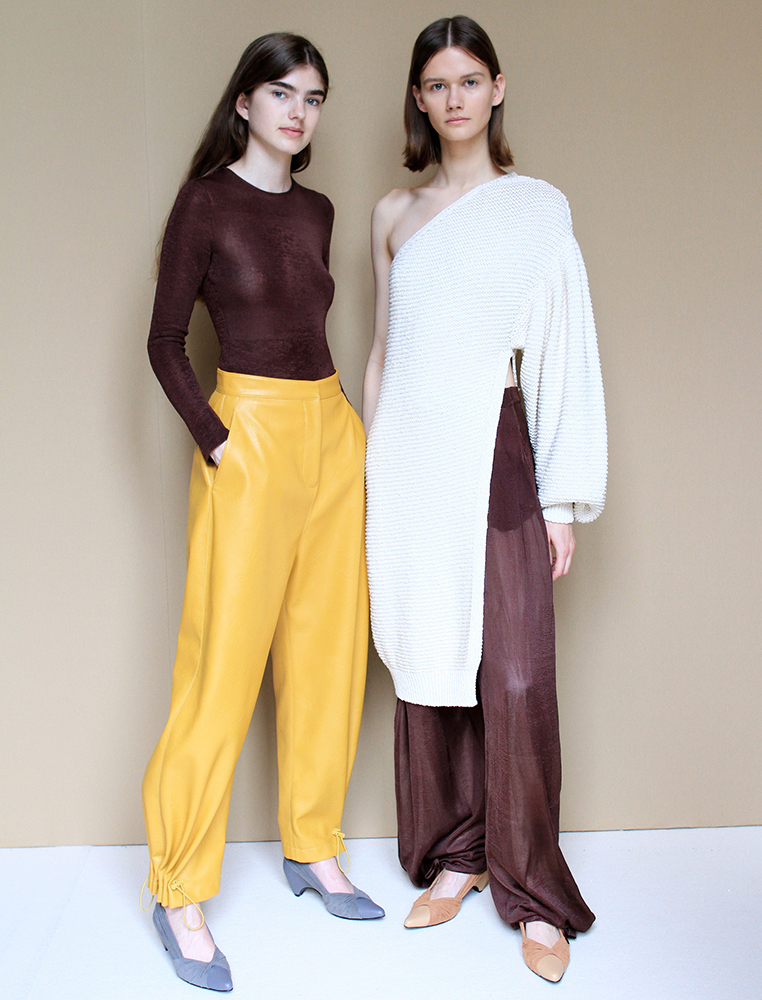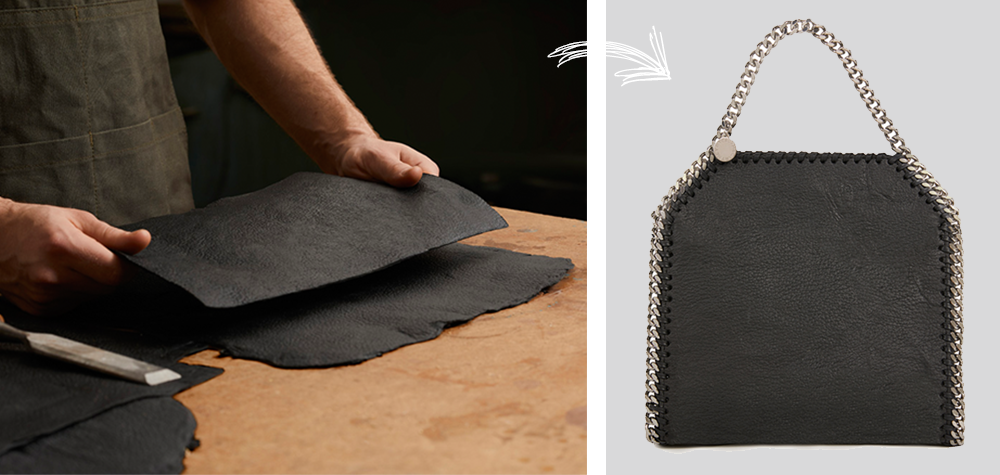The fashion industry has a major sustainability problem. Fortunately, things are starting to change thanks to some major innovations in textile development.
Written by Truc Nguyen
It can take 2,650 litres of water to make a single cotton t-shirt, and the global textile industry produces an astounding 1.2 billion tonnes of greenhouse gas emissions per year. At the other end of the product life-cycle, North Americans send 9.5 million tonnes of clothes to landfill annually, most of which could have been reused or recycled, and some of which is still unworn. In the face of these staggering statistics, it’s no wonder that the reduction of the industry’s carbon footprint and improving sustainability have become top priorities for textile manufacturers and brands alike in recent years. Ultimately, it is material innovations (such as a leather made from pineapple leaf fibre and sugarcane-derived EVA foam soles) pursued alongside a commitment to technologies that enable closed-loop systems, that will pave the way forward for a greener fashion future.
“Cotton is biodegradable, but is incredibly water and resource-intensive to produce,” says Anika Kozlowski, Assistant Professor Fashion Design, Ethics & Sustainability at Ryerson University, adding that natural fibres go through a lot of unnatural processes to be made into clothes. Ongoing issues also include the use of banned toxic chemicals and slave labour. “Synthetics are petroleum-based and use less energy to produce, but shed micro fibres which pollute our food and water systems. And they never, ever break down.”


Beyond simply reducing waste and environmental pollution (Adidas and Everlane have committed to deadlines for using only recycled plastic across their entire supply chains, and Frank and Oak has a new denim line that require 95 percent less water and 50 percent fewer chemicals) and improving resource efficiency during the production process, which remain important first steps, fashion’s industry leaders are also making substantive long-term financial investments in sustainable material innovations, including technologies that encourage a closed-loop system.
“There are [now] bio-based materials — where you’re introducing more renewably-sourced components in things that were traditionally derived 100 percent from oil and petroleum— and post-consumer, closed-loop materials — where they’ve actually been in other products, they’ve been collected and they’ve been re-processed into a very usable, functional, repurposed material,” explains Jad Finck, VP of Innovation and Sustainability at Allbirds, an eco-focused, San Francisco-based footwear compny that’s also a Certified B Corp.


At innovation labs around the world — fashion luxury group Kering has a Materials Innovation Lab in Milan, Richemont has a research center in Switzerland’s Microcity hub, and Levi’s has the Eureka Innovation Lab in San Francisco — researchers are developing new, more sustainable materials and introducing industry game-changers like Levi’s WaterLess process and Nike‘s precision-engineered Flyknit sneakers. Allbirds’ new Sugar Zeffers flip flops and Tree Topper sneakers both feature a SweetFoam™ sole, a groundbreaking, carbon-negative EVA foam made from sugarcane that the company will soon be using on the bottom of all of its shoes.
SweetFoam is an open-source material, so other brands can benefit from Allbirds’ years-long R&D process with Brazilian resin provider Braskem. “SweetFoam is really not a small, isolated niche product. It’s a broad based, widely used, very effective product that comes from a renewable source…it’s a world’s first, and something that can be used by so many people,” says Finck. “We want to change the way people make things, and it needs to extend beyond just us to have the maximum effect.”


In this same collaborative spirit, established international brands are partnering with startups in the textile innovation space, creating powerful synergies and moving cutting-edge products beyond the prototype stage. One of the companies in ASICS’ newly launched growth accelerator programme is Madrid-based start-up Pyratex, which focuses on natural fabrics with health benefits, such as a vegetal fibre with embedded protein and amino acids. Outdoor apparel leader The North Face sold a limited-edition parka in 2016 made out of synthetic spider silk, a fibroin-based protein fibre, in partnership with Japan-based Spiber Inc. Designer Stella McCartney has been working with Bolt Threads’ Microsilk material, a bioengineered polymer that mimics spider silk, since the two companies began collaborating in 2017. McCartney has started experimenting with using the company’s mushroom-based Mylo leather for her handbags as well.
In Spring 2018, BOSS Menswear introduced lace-up shoes with a leather-like textured upper made from Piñatex — an eco-textile made using pineapple leaf fibres, an agricultural byproduct sourced from farming cooperatives in the Philippines — and a recycled TPU, or thermoplastic polyurethane, sole. “Piñatex is a great [leather] substitute because alongside its durability, it is also breathable, light and flexible; it is also easily stitched, embossed and cut,” says Melissa Ann Mendoza, Sales and Marketing Manager at Ananas Anam, the London-based company that developed the textile. (Although Piñatex is a more sustainable leather alternative, the company is still working on a bio-based coating that will make it a fully biodegradable material — the resins currently used are petroleum-based.)


Other promising ideas in development include textiles made out of unexpected, sustainable materials like olives (wet-green’s Olivenleder leather is biodegradable and even uses an olive leaf extract tanning agent), mushrooms (Bolt Threads’ vegan leather Mylo material is mycelium-based), and even citrus peels (the first apparel client for Orange Fiber’s lightweight, 100% citrus fabric was Italian fashion house Salvatore Ferragamo). And one New Jersey based start-up, Modern Meadow, has spent years perfecting a range of bio-fabricated leathers made from lab-grown collagen; the resulting material is still at the prototype stage, but promises a smaller carbon footprint than traditional leather and can be created in specific sizes, styles, and shapes, minimizing the amount of waste incurred during the fashion production process.


If lab-created, bio-based materials are one area of promise, another is the fashion industry’s growing push to incorporate or redevelop post-consumer or waste materials into new products, and embrace of a circular economy or closed-loop model. For example, Adidas has launched and sold millions of its UltraBOOST Uncaged Parley shoes, made from upcycled ocean plastic waste and other recycled materials, and created in partnership with the ocean conservation non-profit Parley for the Oceans. Each garment from Everlane’s ReNew outerwear and fleece collection is made using 15 to 60 recycled plastic bottles, and Swedish retailer H&M has introduced materials such as Bionic Yarn, a recycled polyester made from recovered shoreline waste, and Econyl, a regenerated nylon made from items including old fishing nets and carpets, into its accessibly priced Conscious Exclusive collection. (The H&M group has also pledged to use only sustainably-sourced or recycled materials for all of their brands by 2030.)


Beyond recycled plastics, thinking of the millions of tonnes of clothes and fabrics that are sent to landfill each year, companies are also investing in new techniques for recycling and reusing leftover and post-consumer textiles. A joint venture from Spain’s Tejidos Royo textile company and Austria’s Lenzing Group, REFIBRA combines cotton scraps and wood pulp into new TENCEL Lyocell fibres and has produced textiles for international labels such as Reformation, Levi’s and DL1961. Re.VerSo, a platform based in Italy, provides brands including Balenciaga, Gucci and Stella McCartney with wool and yarns that have been re-engineered from European, textile waste. And Swedish outdoors label Fjällräven recycles Italian wool scraps into new Re-wool garments and accessories, which take less energy and fewer resources to produce than those made with virgin wool.
“Textiles made from regenerated fibres need to be used more widely as they become more scalable. This is one significant way the industry is looking to build circularity into fashion,” says Kozlowski. “We need to make use of all the resources embodied in current garments — Ioncell-F, Evrnu, re:newcell are all looking to address this challenge.” These startups are experimenting with innovative, technology-enabled ways to recycle old garments and textile scraps, even those made out of fabric blends, into strong fibres for new products. And although not all of the technology is scalable or commercially viable yet, there are promising first steps.
Seattle-based Evrnu has collaborated with Levi’s on prototype jeans made from recycled cotton T-shirts, while London-based Worn Again, which is working on methods for recycling cotton-polyester fabric blends, has received investments from industry stalwarts including Kering and H&M. Ioncell, developed by university researchers in Finland over the last decade, uses an ionic liquid solvent to turn cellulose into fibres, portending a future where pulp, used textiles, and even newspapers can be converted into durable fabrics.
“The whole supply chain is waking up to the fact that this isn’t just a fad or a trend, it’s the direction that the industry has to move into,” says Finck. “The big companies that can help make it real are working in lockstep and partnership with smaller companies to launch these new, innovative products.”
Whether the textile products of the future are made out of pineapple leaf, recycled marine plastics, Brazilian sugarcane or used t-shirts, two encouraging ideas can be glimpsed through these exciting innovations: with enough effort, fashion’s enormous, unsustainable carbon footprint can be significantly reduced; and, within the next decade, we may all be able to exclusively wear clothes, made from non-virgin materials, that are either biodegradable or fully recyclable.








